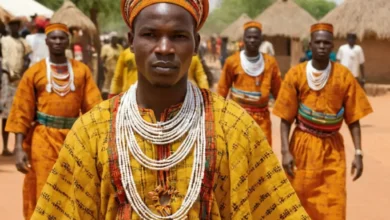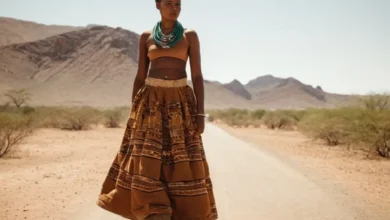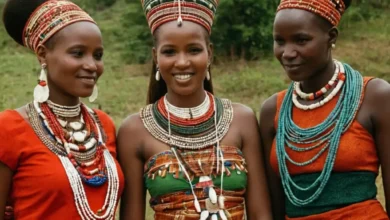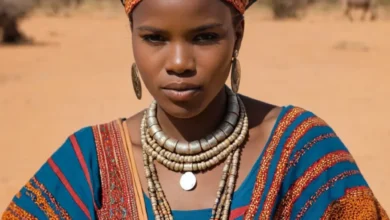Ethiopian Traditional Clothing
Ethiopia, a land steeped in ancient history and vibrant culture, boasts a captivating array of traditional clothing. From the iconic Habesha Kemis to the intricate Tella, these garments are more than just fabric; they are living testaments to generations of craftsmanship, cultural values, and national pride. In this article, we delve into the fascinating world of Ethiopian traditional clothing, exploring its history, significance, and the intricate details that make it so unique.
A Journey Through Time: The Evolution of Ethiopian Dress
The history of Ethiopian clothing is intertwined with the nation’s rich cultural heritage. Evidence suggests that the earliest forms of clothing were simple, consisting of animal skins and woven materials. Over time, the use of cotton and silk became more prevalent, leading to the development of elaborate textiles and intricate designs.
During the Aksumite period (1st century BCE to 7th century CE), trade routes brought new influences, enriching the textile industry and the variety of clothing styles.
The Influence of Religion and Royalty
Religion has played a pivotal role in shaping Ethiopian clothing traditions. Christianity, which arrived in the 4th century CE, brought with it influences from the Byzantine Empire. This is evident in the adoption of the Habesha Kemis as a ceremonial garment for both men and women. The elaborate embroideries and intricate patterns found on these garments often depict religious motifs and stories from the Bible.
See also Gabonese Traditional Clothing: Reflecting Rainforest and Coastal Traditions
Gabonese Traditional Clothing: Reflecting Rainforest and Coastal Traditions
The Ethiopian royal court also exerted a powerful influence on clothing styles. Throughout history, emperors and empresses have patronized skilled artisans, commissioning lavish garments and textiles that reflected their power and prestige.
The Netela and Tella, for instance, were reserved for the elite, highlighting their social standing within the society. This tradition of royal patronage fostered a flourishing textile industry, where skilled weavers and embroiderers honed their craft, creating garments that showcased the country’s artistic brilliance.
Exploring the Fabric of Identity: Key Garments and Their Significance
Ethiopian traditional clothing is characterized by its diverse array of garments, each carrying specific cultural significance. Here, we delve into some of the most prominent and recognizable items:
Habesha Kemis: A Symbol of Elegance and Tradition
The Habesha Kemis is arguably the most iconic garment in Ethiopia. This long, flowing robe, typically made from cotton, silk, or velvet, is worn by both men and women, often during special occasions and religious ceremonies.
See also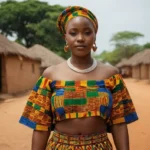 Ghanaian Traditional Clothing: The Vibrant Colors and Patterns of Kente
Ghanaian Traditional Clothing: The Vibrant Colors and Patterns of Kente
The Kemis is a symbol of elegance and sophistication, embodying the cultural heritage and spiritual values of the Ethiopian people. It is usually adorned with intricate embroidery, embellishments, and vibrant colors, reflecting the wearer’s taste and social status.
The Kemis is worn with a variety of accessories, including:
- Shama: A traditional headwrap worn by both men and women. The style and color of the Shama can vary depending on the wearer’s region and personal preferences.
- Netela: A rectangular piece of cloth worn as a shawl or draped over the shoulders. The Netela is often adorned with elaborate embroidery and intricate designs, symbolizing the wearer’s wealth and status.
- Tella: A woven cotton fabric, usually worn as a skirt or wrap around the waist. The Tella comes in various colors and patterns, each with its unique meaning and cultural significance.
- Abay: A long, white garment worn by men over the Kemis. The Abay is often made from fine linen or cotton and is considered a symbol of purity and spiritual devotion.
- Jewelry: Ethiopian traditional jewelry plays a significant role in complementing the attire, enhancing its beauty and cultural significance.
The Intricacies of Tella and Netela
The Tella and Netela are essential elements of Ethiopian traditional clothing, reflecting the country’s rich weaving and textile heritage. The Tella, a woven cotton cloth, is traditionally worn as a skirt by women, while the Netela, a rectangular cloth, is draped over the shoulders as a shawl. These garments are known for their intricate patterns and vibrant colors, showcasing the artistic skill and craftsmanship of Ethiopian weavers.
The Tella is often woven in a variety of stripes, checks, and geometric designs, with each pattern carrying a specific meaning and representing a particular region or ethnic group. For example, the Tella from the Tigray region is known for its bold stripes and geometric patterns, while the Tella from the Gonder region is characterized by its floral and paisley motifs.
The Netela is similarly diverse, showcasing a wide range of colors, textures, and designs. Its embroidery, often featuring intricate motifs and floral patterns, reflects the wearer’s social status, marital status, and religious affiliation. The Netela is considered a symbol of elegance, sophistication, and cultural identity.
Regional Variations: A Tapestry of Diversity
Ethiopian traditional clothing exhibits significant regional variations, reflecting the country’s diverse ethnic groups and cultural identities. Each region boasts its unique styles, fabrics, and patterns, contributing to the vibrant tapestry of Ethiopian fashion. Some notable regional variations include:
- Tigray: Known for its bold, geometric patterns and rich colors, often incorporating intricate embroidery and beadwork.
- Gonder: Characterized by its floral motifs, paisley patterns, and delicate embroidery, emphasizing elegance and sophistication.
- Amhara: Featuring a blend of traditional styles and modern influences, with a focus on intricate embroidery and luxurious fabrics.
- Oromo: Known for its vibrant colors, bold prints, and distinctive headwear, often incorporating traditional motifs and symbolic patterns.
- Sidama: Characterized by its intricate beadwork, colorful textiles, and elaborate headwear, showcasing the unique cultural heritage of the Sidama people.
Beyond Garments: The Art of Adornment
Ethiopian traditional clothing is not solely about garments but also encompasses a rich tradition of adornment. From intricate jewelry to decorative headwear, these accessories play a vital role in complementing the attire, adding to its cultural significance and visual appeal.
Jewelry: A Reflection of Culture and Status
Ethiopian jewelry is a testament to the country’s artistic heritage, often showcasing intricate designs, vibrant colors, and precious materials. From delicate necklaces to elaborate earrings, bracelets, and anklets, jewelry plays a significant role in complementing the attire and enhancing its aesthetic appeal.
The types of jewelry worn vary depending on the region, ethnic group, and social status of the wearer. Some common types of jewelry include:
- Embroidered necklaces: Ornamented with intricate beadwork, often depicting floral and geometric patterns, reflecting the wearer’s cultural identity and status.
- Silver earrings: Popular among women, often adorned with intricate designs and precious stones, showcasing the craftsmanship and artistry of Ethiopian silversmiths.
- Bracelets: Widely worn by both men and women, made from various materials like silver, gold, beads, and leather, often symbolizing wealth, social status, and cultural heritage.
- Anklets: Traditionally worn by women, often made from silver, gold, or beads, complementing the attire and adding to its aesthetic appeal.
Headwear: A Symphony of Colors and Patterns
Ethiopian traditional headwear is a captivating display of colors, patterns, and styles, showcasing the country’s diverse cultural heritage and the craftsmanship of its artisans. From the simple Shama worn by both men and women to the elaborate headwear worn by specific ethnic groups, these accessories add a unique dimension to the attire, enhancing its cultural significance and visual appeal.
Some notable types of Ethiopian traditional headwear include:
- Shama: A traditional headwrap worn by both men and women, often made from cotton or silk, and tied in a variety of styles.
- Gish: A traditional head covering worn by women in Tigray, often made from cotton or silk and adorned with elaborate embroidery and intricate designs.
- Netela: A rectangular piece of cloth that can be draped over the head as a shawl or tied as a headwrap, adding a touch of elegance and sophistication to the attire.
- Kaba: A traditional hat worn by men in the Amhara region, typically made from felt or straw and adorned with decorative embellishments.
- Azebo: A traditional headwear worn by women in the Oromo region, often made from brightly colored fabrics and adorned with intricate beadwork and decorative elements.
Preserving the Legacy: The Importance of Ethiopian Traditional Clothing
Ethiopian traditional clothing is more than just fabric; it is a tangible manifestation of the country’s rich cultural heritage, preserving traditions, values, and stories passed down through generations. The art of weaving, embroidery, and dyeing, practiced for centuries, plays a vital role in preserving these traditions, fostering a sense of community, and contributing to the country’s economic development.
Embracing Tradition in a Modern World
In today’s globalized world, where modern trends often overshadow traditional practices, it is crucial to preserve the legacy of Ethiopian traditional clothing. This involves promoting awareness and appreciation for the cultural significance of these garments, supporting local artisans, and encouraging the use of traditional techniques and materials.
Many contemporary Ethiopian designers are integrating traditional elements into their modern designs, creating a fusion of traditional and contemporary styles that appeal to a global audience. This approach helps to bridge the gap between tradition and modernity, ensuring that Ethiopian traditional clothing remains relevant and accessible to a new generation.
FAQs
Why is Ethiopian traditional clothing so diverse?
The diversity of Ethiopian traditional clothing is a reflection of the country’s diverse ethnic groups and cultural identities. Each region has its own unique styles, fabrics, and patterns, reflecting their distinct traditions and beliefs. This diversity is a testament to the rich cultural tapestry of Ethiopia.
What is the significance of the colors used in Ethiopian traditional clothing?
Colors play a significant role in Ethiopian traditional clothing, often carrying symbolic meaning and cultural significance. For example, white is associated with purity and spirituality, red with strength and passion, and green with fertility and prosperity. The specific colors used can vary depending on the region, ethnic group, and the occasion for which the garment is worn.
How can I support the preservation of Ethiopian traditional clothing?
You can support the preservation of Ethiopian traditional clothing by:
- Purchasing from local artisans: Patronize artisans who create traditional garments and accessories, ensuring that their skills and traditions are passed down to future generations.
- Educating yourself and others: Share your knowledge and appreciation for Ethiopian traditional clothing with your friends, family, and community, promoting awareness and understanding of this important cultural heritage.
- Supporting organizations: Donate to organizations that work to preserve Ethiopian traditional clothing, providing resources and training to artisans and communities.
Conclusion
Ethiopian traditional clothing is a captivating blend of history, culture, and artistry, reflecting the country’s rich heritage and the creativity of its people. From the iconic Habesha Kemis to the intricate Tella and Netela, these garments are more than just fabric; they are living testaments to generations of craftsmanship, cultural values, and national pride.
As we continue to embrace the globalized world, it is crucial to preserve the legacy of Ethiopian traditional clothing, ensuring that its beauty, significance, and cultural richness remain alive for generations to come.
